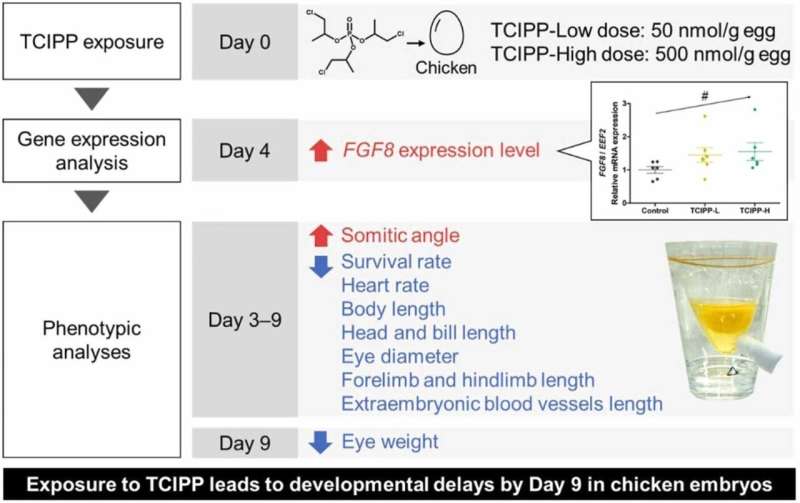This article has been reviewed according to Science X's editorial process and policies. Editors have highlighted the following attributes while ensuring the content's credibility:
fact-checked
trusted source
proofread
Study results indicate organophosphorus flame retardants induce malformations in avian embryos

Tris(2-chloroisopropyl) phosphate (TCIPP) is one of the organophosphorus flame retardants that has been detected in the environment, and in the eggs, feathers, and liver of birds. Early developmental avian embryos are known to be sensitive to chemical exposure, but knowledge regarding the effects of TCIPP on avian embryonic development is limited.
In a recent study, a shell-less embryo incubation system was used to investigate the toxicity of TCIPP in early chicken (Gallus gallus domesticus) embryos. The results have been reported in Ecotoxicology and Environmental Safety.
Fertilized chick embryos were exposed to 50 nmol TCIPP/g, 500 nmol TCIPP/g, or vehicle control, dimethyl sulfoxide (DMSO) on day 0 of incubation. Embryos were observed on days three to nine of incubation, and expression levels of several genes were measured in embryos on day four.
Survival was significantly reduced in both groups exposed to TCIPP. Imaging analysis showed that body length, head and bill length, eye diameter, and forelimb and hindlimb length were significantly reduced in both groups exposed to TCIPP.
In addition, TCIPP exposure significantly inhibited extraembryonic vascular length and red blood cell production. The heart rate decreased in a dose-dependent manner, particularly on days four to seven, and the somitic angle was significantly increased on days four to six in the TCIPP-exposed group, inducing asymmetrical somite formation.
The significant correlation between somitic angle and FGF8 expression suggested that TCIPP exposure affects somite formation through an altered FGF signaling pathway.
These results indicate that TCIPP exposure exerts toxic effects on development, including vascularization, cardiac function, and somite formation in avian embryos.
More information: Kaori Chigusa et al, Developmental toxicity in early chicken embryos on exposure to an organophosphorus flame retardant, tris(2-chloroisopropyl) phosphate, Ecotoxicology and Environmental Safety (2023). DOI: 10.1016/j.ecoenv.2023.115445
Provided by Ehime University





















